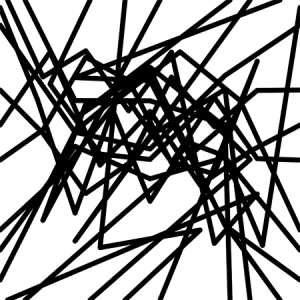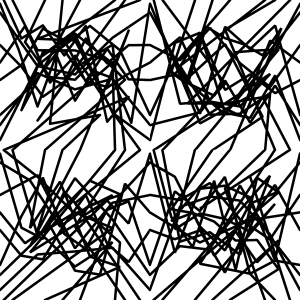9. November 2010
Konzept Ich wollte ein Ornament in Processing erstellen welches sich von Rendering zu Rendering unterscheidet, allerdings in Y- und X- Richtung duplizierbar bleibt (Pattern). Die Grundidee war es horizontale und vertikale Linien zu Zeichnen die sich wiederrum in Segmente unterteilen... pro Segment wird ein zufälliger Wert für die Y-Achse bei Horizontalen Linien undein zufälliger Wert für die X-Achse bei Vertikalen Linien gewählt. So erhält man bei jedem neuen Rendering ein neues Ornament welches als Pattern kombinierbar mit den anderen bleibt:

/*
* ORNAMENT
*
* Predefined dockingPoints where the ornament starts and ends on the x-axe and
* y-axe to provide the functionality of reproducing this ornament itselfs on
* the y-axe and x-axe with a clear flow into each other
*
* @name ORNAMENT
* @author Sebastian Pape <sebastian.pape@zhdk.ch>
* @version 0.9
*/
import processing.pdf.*;
/*
* SEGMENTS
*
* The spreaf of possible segments for each line
*
*/
int segmentsMin = 2;
int segmentsMax = 8;
/*
* DOCKING POINTS
*
* The docking poits array defines points where the ornament starts and end
* seperated in y-axe and x-axe
*
*/
ArrayList dockingPointsXAxe = new ArrayList();
void fillDockingPointsXAxe() {
dockingPointsXAxe.add(15);
dockingPointsXAxe.add(50);
dockingPointsXAxe.add(180);
dockingPointsXAxe.add(250);
dockingPointsXAxe.add(320);
dockingPointsXAxe.add(460);
dockingPointsXAxe.add(500);
dockingPointsXAxe.add(560);
}
ArrayList dockingPointsYAxe = new ArrayList();
void fillDockingPointsYAxe() {
dockingPointsYAxe.add(25);
dockingPointsYAxe.add(60);
dockingPointsYAxe.add(145);
dockingPointsYAxe.add(222);
dockingPointsYAxe.add(324);
dockingPointsYAxe.add(445);
dockingPointsYAxe.add(488);
dockingPointsYAxe.add(571);
}
/*
* SETUP
*/
void setup() {
size(600,600,PDF,"ornament.pdf"); // def. fenstergroesse
//size(600, 600);
smooth(); // aktiviere antialiasing
strokeWeight(10); // linienbreite
strokeJoin(BEVEL);
fillDockingPointsXAxe();
fillDockingPointsYAxe();
noLoop();
}
/*
* DRAW
*/
void draw() {
background(255); // def. hintergrundfarbe
drawLines();
exit();
}
/*
* DRAW LINES
*/
void drawLines() {
// horizontal lines
for (int i = 0; i <= dockingPointsXAxe.size()-1; i++) {
drawLine(0,((Integer)dockingPointsXAxe.get(i)).intValue());
}
// vertical lines
for (int i = 0; i <= dockingPointsYAxe.size()-1; i++) {
drawLine(((Integer)dockingPointsXAxe.get(i)).intValue(), 0);
}
}
/*
* DRWAW LINE
*/
void drawLine(int startPointX, int startPointY) {
float segments = round(random(segmentsMin, segmentsMax));
// first point to check if the current line is a horizontal or vertical line
float firstX = startPointX;
float firstY = startPointY;
// last point for the for drawing lines during the for loop
float lastX = firstX;
float lastY = firstY;
for(int i = 1; i <= segments; i++) {
// set the current point
float currentX = width / segments * i;
float currentY = 100 + (height - 200) * random(1);
if(i == segments) {
// let the last drawn part ends where the line begins
currentX = firstX;
if(currentX == 0) {
currentX = width;
}
currentY = firstY;
if(currentY == 0) {
currentY = height;
}
}
// draw line
line(lastX, lastY, currentX, currentY);
// set last point
lastX = currentX;
lastY = currentY;
}
}